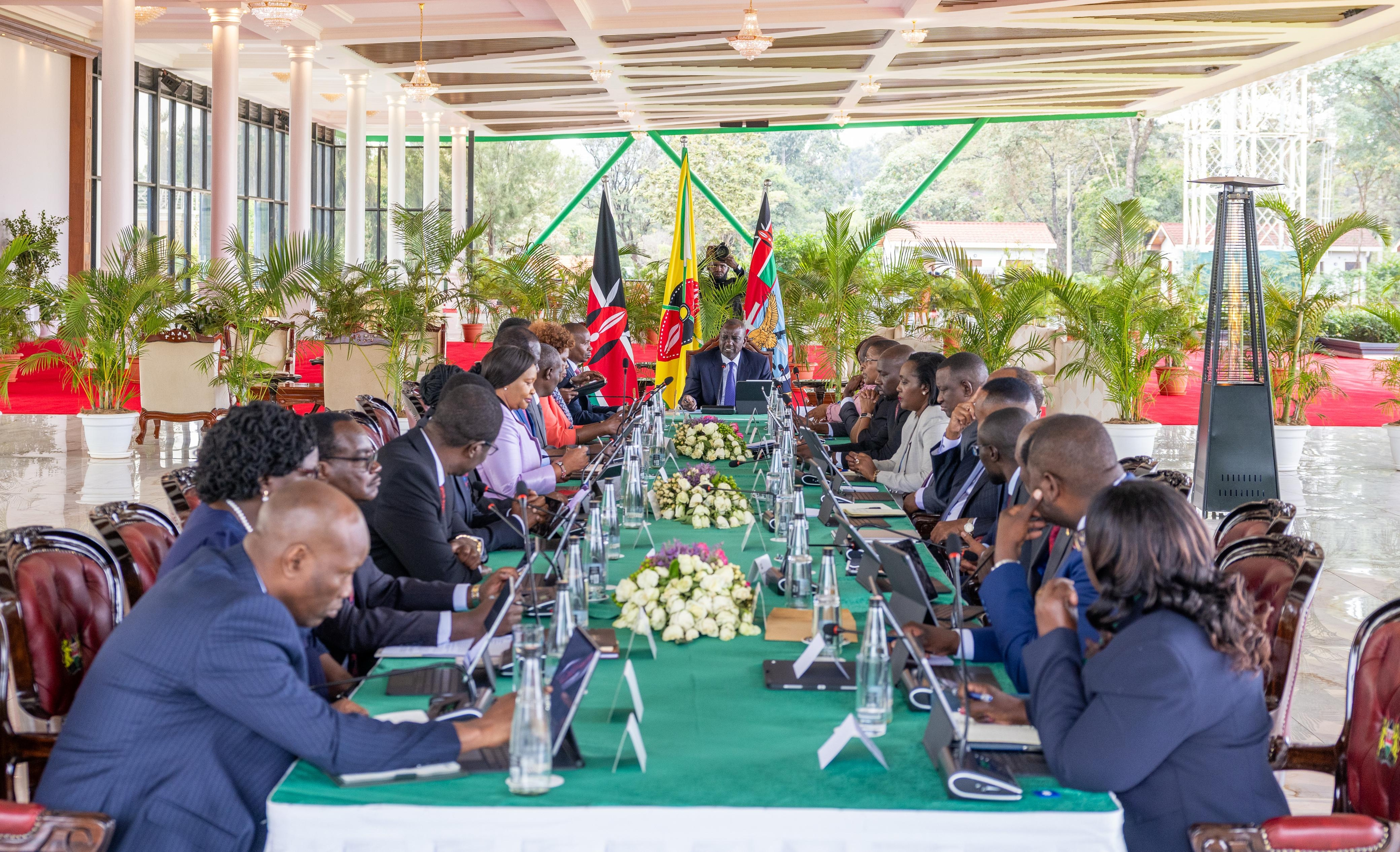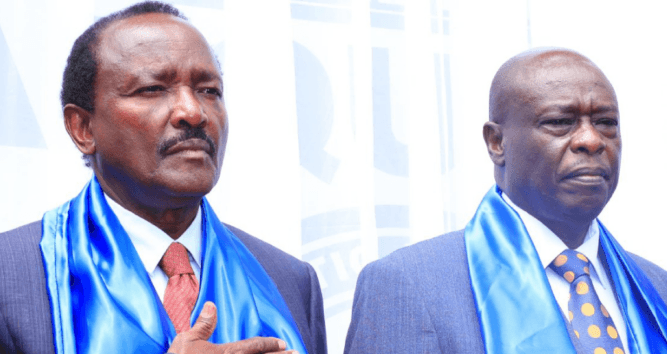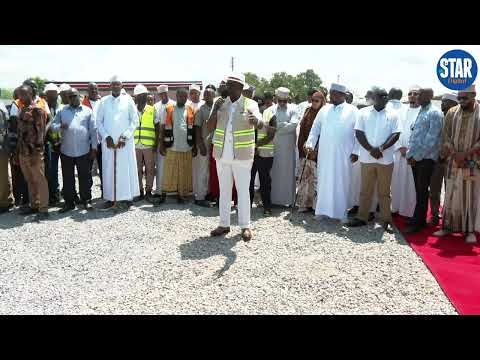Former President Mwai Kibaki launched the Vision 2030 development blueprint on June 10, 2008, to drive the country's growth agenda for the next 22 years.
The economist dreamt of having Kenya become an industrialised, middle-income country providing a high quality of life to all its citizens by 2030.
The blueprint was anchored on three pillars: economic, social and political.
The former President had steadied the economy, with the country's GDP shooting from 0.6 per cent in 2002 when he came into power, to 6.1 per cent in 2006.
The current administration has retained aspects of Vision 2030 in its development agenda, with infrastructure, science, technology and innovation, public sector reforms, tourism and agriculture sectors given prominence.
Manufacturing, business process outsourcing, information communication and technology, financial services and education and training complete the 10 focus areas for the Jubilee administration.
THIKA SUPERHIGHWAY
The Sh36.9 billion 50km Nairobi–Thika superhighway was the signal of what could be achieved through the Vision 2030 flagship projects.
Financed by the African Development Bank and the EximBank of China, the road was a game-changer in Nairobi. It opened up the city and supported the growth of the capital's economy.
Light manufacturing, educational institutions and a thriving informal sector business in metalwork, carpentry, vehicle repairs, dressmaking and construction have thrived on the sides of the highway.
Access to the city from the industrial town of Thika has been boosted. Farmers from Central Kenya get their produce to the capital, both for domestic and export faster.
“Give credit where it is due, Mzee (Kibaki) gave us one thing that we will never forget, connectivity,” Roy Nyaga, a Nairobi textile entrepreneur, says.
Residents of Roysambu, Kasarani, Githurai, Ruiru, Juja and even Thika remain among the biggest beneficiaries of the project.
MOMBASA PORT
In December 2012, President Kibaki presided over the groundbreaking of what would shape today's port operations in the country, including the exit of container freight stations from the business.
A second container terminal worth Sh27.8 billion was built to create space for additional 1.2 million containers.
The Japanese government through JICA agreed to finance it under its ODA loan programme. The Mombasa port development is one of the biggest single ODA projects in Japan's history of economic cooperation with Kenya.
With annual cargo handling capacity having increased from 250,000 TEU in 2008 to the current above 1.4 million TEU’s, Kibaki's leadership takes credit for expanding the Port of Mombasa.
The second container terminal's phase one is operational with a capacity of 550,000 22-foot equivalent unit.
Port capacity is further expected to increase once phase two of the second container terminal is complete.
KPA has reclaimed 50 acres of land for the terminal which will add 450,000 TEUs, and a further additional 400,000 TEUs in phase three.
The port also underwent other development and reforms during Kibaki's tenure, ensuring the country remains at par with changing global maritime and logistic trends.
LAPSSET
The Lamu Port South-Sudan-Ethiopia Transport corridor is yet another mega project initiated by the former President.
The corridor stretches from the new Port of Lamu through Garissa, Isiolo, Mararal, Lodwar and Lokichoggio to branch at Isiolo to Ethiopia and Southern Sudan. It was launched in 2012.
It comprises a new road network, a railway line, oil refinery at Lamu, oil pipeline, Isiolo and Lamu Airports and a free port at Lamu (Manda Bay) in addition to resort cities at the coast and in Isiolo.
Lack of political goodwill, low funding, and other regional projects are however proving to be a challenge that are slowing down the project.
The port's first berth was completed in 2019, years after Kibaki left office.
Two more berths have been constructed, with the government hoping investors would come on board to develop the remaining 29 berths of the planned 32-berth port facility, which will become Kenya's second major seaport.
In April 2021, Kenya National Highway Authority and China Communications Construction Company signed a Sh17.9 billion deal to construct the 453km Lapsset corridor.
The road construction comprises the 257-km Lamu-Ijara-Garissa section which will be a key route for cargo evacuation from the Port to partner states Ethiopia and South Sudan.
The project is expected to create the country's second major trading corridor after the Northern Corridor which runs from the Port of Mombasa into Uganda and other neighbouring countries.
KONZA CITY
Another Kibaki legacy is the Konza Technopolis. This is a key flagship project the Vision 2030 economic development portfolio.
Konza is envisioned to be a world-class city, powered by a thriving ICT sector, superior reliable infrastructure and business-friendly governance systems.
Kibaki laid the foundation stone for the project formerly known as Konza Technology City on January 23, 2013.
Located 60 kilometres from the capital Nairobi, Konza will occupy 5,000 acres of land. It is envisioned to provide more than 17,000 jobs.
It is designed as a walkable city complete with universities, research facilities, smart technologies, business facilities.
It is expected to grow into a vibrant community of over 200,000 when it is finished.
The project has yet to fully pick though investors have been warming up to it.
ROADS
Vision 2030 outlined a number of roads for construction, some of which are operational.
They include projects under the Northern Corridor Transport Improvement Project among them being Miritini to Maji ya Chumvi (35 km), Sultan Hamud to Machakos Turn-off (55km), Machakos Turnoff-Athi River-JKIA (59.5km) and Maai Mahiu-Naivasha-Lanet (94km).
Other projects are Lanet-Nakuru-Njoro Turnoff (15km), Njoro Turnoff-Mau Summit-Timboroa (83km), Timboroa-Eldoret (73km), Eldoret-Webuye (60km) and Webuye-Malaba (62km).
Completed road projects under the East African Road Network Project include upgrading of Athi River-Namanga Road (136km) and Emali-Oloitokitok (100km).
SH56 BILLION GREEN FIELD TERMINAL
This project never saw the light of the day after being highly politicised because of differences between Kibaki and former Prime Minister Raila Odinga.
The tender for the design of the Greenfield Passenger Terminal was awarded on December 16, 2011 to Anhui Construction Engineering Group in a joint venture with China Aero Technology International Engineering Corporation.
Acceptance for the works was received by the aviation authority in December 2011.
Concerns were raised by stakeholders on the need to separate funding arrangements and the works at the tender stage.
After consultations with various arms of government, the Cabinet in its meeting of September 13, 2012 instructed that the project should go ahead. The contract had been signed on September 14, 2012.
The project was later scrapped by President Uhuru Kenyatta’s government for lack of funds.
Kibaki's tenure however saw the improvement of airport facilities across the country, investments in geothermal energy among other clean electricity sources.
Kibaki's vision for transforming the country and stabilising the economy began with great promise but was later rocked by high public debt.












![[PHOTOS] Ruto present as NIS boss Noordin Haji's son weds](/_next/image?url=https%3A%2F%2Fcdn.radioafrica.digital%2Fimage%2F2025%2F11%2Ff8833a6a-7b6b-4e15-b378-8624f16917f0.jpg&w=3840&q=100)




